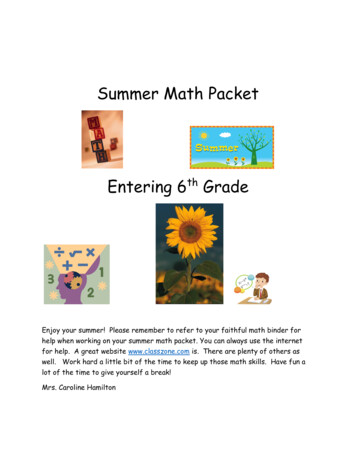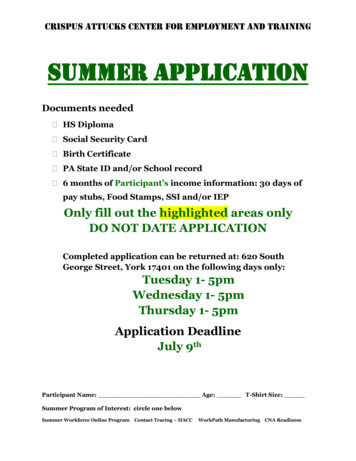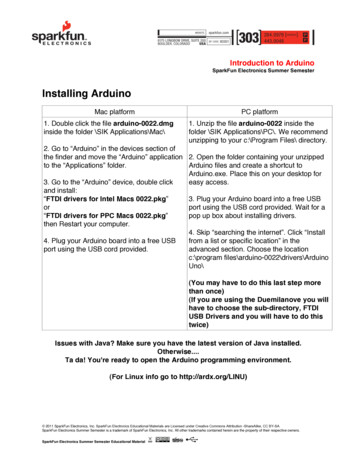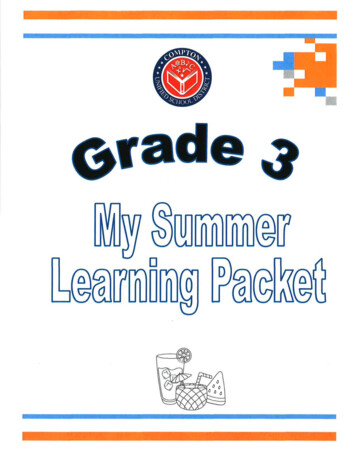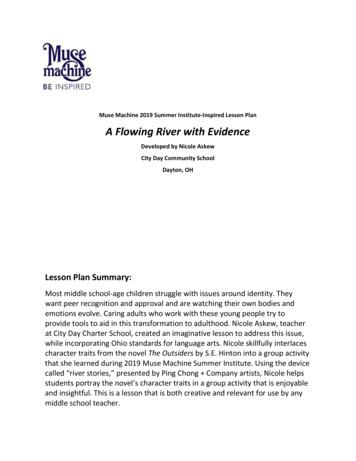
Transcription
Muse Machine 2019 Summer Institute-Inspired Lesson PlanA Flowing River with EvidenceDeveloped by Nicole AskewCity Day Community SchoolDayton, OHLesson Plan Summary:Most middle school-age children struggle with issues around identity. Theywant peer recognition and approval and are watching their own bodies andemotions evolve. Caring adults who work with these young people try toprovide tools to aid in this transformation to adulthood. Nicole Askew, teacherat City Day Charter School, created an imaginative lesson to address this issue,while incorporating Ohio standards for language arts. Nicole skillfully interlacescharacter traits from the novel The Outsiders by S.E. Hinton into a group activitythat she learned during 2019 Muse Machine Summer Institute. Using the devicecalled “river stories,” presented by Ping Chong Company artists, Nicole helpsstudents portray the novel’s character traits in a group activity that is enjoyableand insightful. This is a lesson that is both creative and relevant for use by anymiddle school teacher.
Name: Nicole AskewSchool: City DayCommunity SchoolSubject: 7th ELA/ReadingDate: 12/9/2019Inspiration:During Muse Machine’s Summer Institute 2019, Ping Chong Companypresented the topic of Understanding and Self. They taught us awriting/storytelling method called “River Stories” to help students understandthis topic.Title: A Flowing River with EvidenceI. OVERVIEWA. Summary: In this lesson, students will collaborate with their peers toanswer questions about a passage after reading it by citing textualevidence. They will then refer to the novel The Outsiders to write textualevidence of some of the characters on a “stone” and place it on the paperriver. Students will also explain the reasoning behind their choice. Theywill then take that evidence and, as a class, create a River Story.B. Standards:7.RL.1 Cite several pieces of textual evidence to support analysis of whatthe text says explicitly as well as inferences drawn.7.RL.3 Analyze how particular elements of a story or drama interact (e.g.,how setting shapes the characters or plot.)C. Objectives/Outcomes: Students will be able to analyze a text. Students will cite specific textual evidence to support analysis ofliterary text as well as support for inferences Students will be able to identify and analyze character traits.D. Teaching Approach: Whole group & small group instructionE. Assessment: Oral (Student responses of text evidence) Written (River Stones of evidence) Character Sketch based on evidence (River Story)II. LESSON PREPARATIONA. Teacher Needs: The Outsiders by S.E. Hinton (Students should have the first four orfive chapters read prior to this lesson.)3 sheets of chart paper (Draw a river on each one and label oneheading: Ponyboy, another one: Johnny and the third one: Dally)Teacher-created small pieces of paper shaped like stones (provideeach student with 3 stones)Selections from Who Is Tom?“My Shadow” poem by Robert Louis 3196/my-shadow)Askew 1
Character Sketch (the adjectives list may help students createbetter character descriptions)Helpful Hints: Showing students samples and creating a few “stones”together” helps to make the directions clearer. Teacher should also beaware of Information about students’ backgrounds and a sensitivity totheir need for privacy in certain situations.B. Student Needs:a. Prior Knowledge: Students will have been previously introduced toidentifying main ideas and supporting details which will assist withproviding textual evidence. Students will also be familiar with most ofthe characters in the novel prior to this lesson. Students have writtenstories before; however, this is an introduction to River Stories.b. Student Voice: Students can work with peers of their own choosing.c. Vocabulary: Main idea, details, textual evidence, character traits,character sketch, analyzeIII. EVIDENCE/ASSESSMENTOF OUTCOMESStudents will create a brief character sketch (one to two paragraphs) aboutone of the three characters mentioned in this lesson based on the evidencethey provided on the river stones.IV. ENDURINGUNDERSTANDINGSStudents will understand that citing specific textual evidence adds necessaryinformation and credibility to the analysis of a text.V. LEARNING PLANA. Prompt: I will ask students the following question: How can you tell that Iam a reading teacher? (They may respond by pointing out some of theitems they see around the room, posters, books, things we’ve done inclass, etc.)B. Hook: Teacher will display and read aloud the first stanza of “My Shadow”by Robert Louis Stevenson to the class (dramatically or in some othervoice).C. Essential Questions: How do you define evidence? What do you think ofwhen you think about evidence? How do the traumatic events in one’s lifeshape behaviors?D. Resources: As described under Teacher NeedsE. Teacher and Student Performance Tasks:Warm-Up: Project/display “My Shadow” by Robert Louis Stevenson andrefer to the first stanza. Ask students to cite evidence that Stevenson istalking about his shadow (very, very like me, jumps before me when Ijump into my bed).Askew 2
Guided Practice: Ask students what the word evidence means (ex.obvious, a thing or things helpful in forming a conclusion or judgment, asign). Ask students what they think of when they think about evidence (ex.evidence submitted in a court to prove a case). Explain that writersinclude evidence in their stories to help the reader understand thecharacters and the events happening in the story.Project/display page 1 of Who is Tom? and read the text aloud. Askstudents to characterize Tom (ex. he is forgetful). Ask students why he isforgetful. Students may say the text doesn’t allow for inference. Thendisplay page 2 of Who is Tom? and read the text aloud. Ask students whyTom is forgetful. (ex. Mom was too busy to wake him up in time to getready for school. Tom may be stressed himself because of twin babies inthe house, dad working long hours, etc.) Point out that the author givesplenty of textual evidence to help the reader understand Tom’s problems.Issue teacher-created small pieces of paper that are shaped like stones.Explain to students that they will write down textual evidence on thestones that answer questions about some of the characters in TheOutsiders by S.E. Hinton. We will then list at least two character traits forPonyboy, Johnny and Dally (three separate rivers).Leading Questions:How can you compare/contrast how Johnny and Ponyboy feel aboutDally? What kind of person is Dally? What evidence can you find tosupport that?Independent: After all the stones have been placed on the river, studentswill then choose a river (character) to write a character sketch about.Students will write approximately two paragraphs that describe thecharacter of their choosing based on the river stones.F. Final Review:Closing Activity: Have a few students share their character sketches withthe class and have them explain why they included at least one of thepieces of evidence in their sketch.Exit Pass (optional): Have students write one thing they learned, onething they liked, and one question they still have on a half sheet of paper.VI. LESSON REFLECTIONI was unsure how I would incorporate the River Story into a reading lesson.However, I must say that I rather enjoyed the response from my students.They really enjoyed the activity. It helped them to think about how well theyknew each character from the novel and if they needed to analyze thecharacters some more.Askew 3
Implementing this lesson gave me ideas of other ways that I can possibly usethe River Story idea. I am sure that I will teach this lesson again with otherclasses. In the future, however, I will take a little more time to explaincharacter traits at the start of the lesson. Though my students had previouslylearned about character traits and had also completed other activitiesregarding the topic, a few of them seemed to struggle with what to write ontheir stones about each character. Overall, I think the lesson went well.Askew 4
(Display Page 1)Who is Tom?As Tom ran up the steps, the tardy bell sounded its familiar chastisement.Its shrill sound reminded him of his mother’s morning alert.“Don’t forget your spelling book,” Mother had called out as Tom franticallylooked for his jacket.The sudden realization that his spelling book was still on the kitchen tableslowed his steps to a deliberate stomp that kept time with the tardy bell.You did it again. You did it again. His feet seemed to say.
(Display page 2)Who is Tom?Tom hurried up the steps two at a time as the tardy bell sounded its familiarchastisement. Its shrill sound reminded him of his mother’s morning alert.“Don’t forget your spelling book,” Mother had called out as Tom franticallylooked for his jacket. “It’s on the kitchen table.”Mom had been bathing one of the twins that morning instead of waking himup. He couldn’t wait until his baby brothers were older. It was bad enoughthat Dad had to leave for work before anyone woke up. Tom was nowexpected to act like he was in high school instead of third grade. It wasn’tfair.As the tardy bell continued to sound, the sudden realization that his spellingbook was still on the kitchen table slowed his steps to a deliberate stompthat kept time with the bell.You did it again. You did it again. His feet seemed to say.
Writers WorkshopCharacter Sketchby Jim CornishWhat a Character!A character sketch informs you about the character in a book. When you write a charactersketch, you want the reader to have a strong mental image of the person including how theperson talks, acts and thinks. This handout is designed to help you write that sketch. It providesa list of words that can be used to describe a person and a list of the types of things you canwrite about.Adjectives to Describe a kunsmilingslyfoolishwildunhappydeceitfulserious Prepared By Jim Cornish, Gander, Newfoundland, Canada.
Writing a Character SketchConsider the following about your character:GGGGGGGGGGgender, age and nameappearancephysical and personal strengths and weaknesseslikes and dislikesfeelings and behaviours towards other charactersfeelings of other characters towards the characterfeelings of character towards himself/herselfpersonality at the beginning of the novelchanges in personality as story progressesyou opinion about the characterIt is important to include proof from the story to support what you are writing in thecharacter sketch. If you can’t support it with something from the story, then it doesn’tbelong.Example of a Character Sketch.Rowan is a twelve year old boy who lives in the tiny village of Rin. He is small and ratherscrawny for his age. His unkempt, curly brown hair looks like a mop on his tiny face andhis thinness makes him look like a walking skeleton.The people in the village poke fun of Rowan. The adults call him a weakling because henever stands up for himself. The children call him a coward because when confrontedwith a problem, Rowan always runs away.Rowan is the gentlest of the children in the village. He is the only child that canapproach any of the farm animals without scaring them away. They trust is soothingtouch and calming voice over the roughness and loudness of the other kids.Rowan faces the greatest challenge of his life. He possess a special gift that he mustuse to save the village from the fierce dragon that lives in the mountain. He starts thejourney afraid of what he might face and worried that he will let the village people down.After facing and winning over his first test, he grows more confident and stronger so thatby the end of the novel, he has all the strength he needs to face his greatest test, aface-to-face meeting with the dragon.I think Rowan doesn’t deserve to be treated so poorly. It takes all kinds of people tomake the world and everyone can teach us something about how to be a better person. Prepared By Jim Cornish, Gander, Newfoundland, Canada.
A Flowing River with Evidence. Developed by Nicole Askew City Day Community School . Dayton, OH; Lesson Plan Summary: . expected to act like he was in high school instead of third grade. It wasn't fair. As the tardy bell continued to sound, the sudden realization that his spelling



